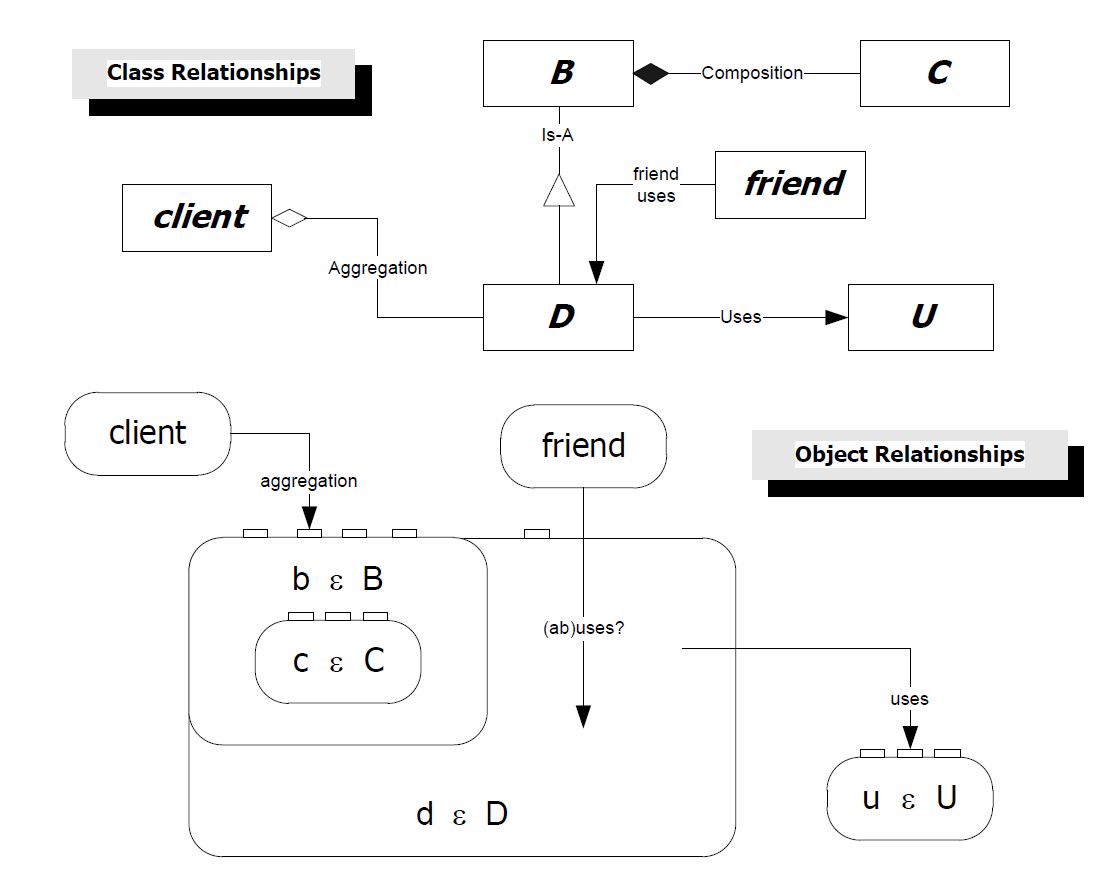
click to close

///////////////////////////////////////////////////////////////////////
// CompObj.cpp - Compound Object Operations //
// //
// Jim Fawcett, CSE687 - Object Oriented Design, Midterm Spring 2016 //
///////////////////////////////////////////////////////////////////////
/*
* The main objectives of this demonstrations are to:
* - illustrate the importance of constructor initialization sequences
* - expose all of the operations that compound objects are expected
* to provide.
*/
#include <iostream>
#include <string>
#include "../Utilities/Utilities.h"
void putMsg(const std::string& msg)
{
std::cout << "\n " << msg.c_str();
}
struct Cosmetic {
~Cosmetic() { std::cout << "\n\n"; }
} GlobalCosm;
///////////////////////////////////////////////////////////////////////
// C class - instances are composed by the base class B
class C
{
public:
C() { putMsg("C default construction"); }
C(const C& c) : name_(c.name_) // note initialization
{
putMsg("C copy construction");
}
C& operator=(const C& c)
{
putMsg("C assignment");
if (this == &c)
return *this;
name_ = c.name_;
return *this;
}
C(C&& c) : name_(std::move(c.name_))
{
putMsg("C move construction");
}
C& operator=(C&& c)
{
putMsg("C move assignment");
if (this == &c)
return *this;
name_ = std::move(c.name_);
return *this;
}
~C()
{
putMsg("C destruction");
}
private:
std::string name_;
};
///////////////////////////////////////////////////////////////////////
// B class - serves as the base of inheritance for D
/*
* B's constructors, as their first act, invoke a C constructor. They
* don't execute their bodies until C's construction completes.
*/
class B
{
public:
B()
{
putMsg("B default construction");
}
B(const B& b) : c(b.c)
{
putMsg("B copy construction");
}
B& operator=(const B& b)
{
putMsg("B copy assignment");
if (this == &b)
return *this;
c = b.c;
return *this;
}
B(B&& b) : c(std::move(b.c))
{
putMsg("B move construction");
}
B& operator=(B&& b)
{
putMsg("B move assignment");
if (this == &b)
return *this;
c = std::move(b.c);
return *this;
}
virtual void g()
{
putMsg("Calling g()");
}
virtual ~B()
{
putMsg("B destruction");
}
private:
C c;
};
///////////////////////////////////////////////////////////////////////
// U class - instances are used by D
class U
{
public:
U()
{
putMsg("U default construction");
}
U(const U& u)
{
putMsg("U copy construction");
}
U& operator=(const U& u)
{
putMsg("U assignment");
return *this;
}
U(U&& u)
{
putMsg("U move construction");
}
U& operator=(U&& u)
{
putMsg("U move assignment");
return *this;
}
~U()
{
putMsg("U destruction");
}
};
///////////////////////////////////////////////////////////////////////
// D class
// - D derives from B.
// - There are no virtual functions because our goal is to
// illustrate operations that occur when a compound object
// is created, assigned, and destroyed.
/*
* D's constructors, as their first act, invoke a B constructor. They
* don't execute their bodies until B's construction completes.
*/
class D : public B
{
public:
D()
{
putMsg("D default construction");
}
D(const D& d) : B(d)
{
putMsg("D copy construction");
}
D& operator=(const D& d)
{
putMsg("D assignment");
if (this == &d)
return *this;
B::operator=(d);
return *this;
}
D(D&& d) : B(std::move(d))
{
putMsg("D move construction");
}
D& operator=(D&& d)
{
putMsg("D move assignment");
if (this == &d)
return *this;
B::operator=(std::move(d));
return *this;
}
virtual void g()
{
putMsg("Calling D::g()");
}
void f(U& u)
{
putMsg("D using U");
}
~D()
{
putMsg("D destruction");
}
};
///////////////////////////////////////////////////////////////////////
// global function testFunction
// - Illustrates move construction from temporary objects.
D testFunction()
{
Utilities::title("Running testFunction");
D d;
return d; // d will be moved, not copied
}
///////////////////////////////////////////////////////////////////////
// Test stub
// - You should experiment with this and with the parts provided
// for the classes.
// - What do you think will happen if you comment out the move
// operations?
int main()
{
Utilities::title("Demonstrating Operation of Compound Object", '=');
U u;
D d;
d.f(u);
d = testFunction();
Utilities::title("starting copy construction");
D d2 = d;
Utilities::title("starting move construction");
D d3 = std::move(d);
// d is now invalid
Utilities::title("Demonstrating polymorphism");
B* ptr = new B();
ptr->g();
ptr = &d;
ptr->g();
Utilities::title("leaving main's scope");
}